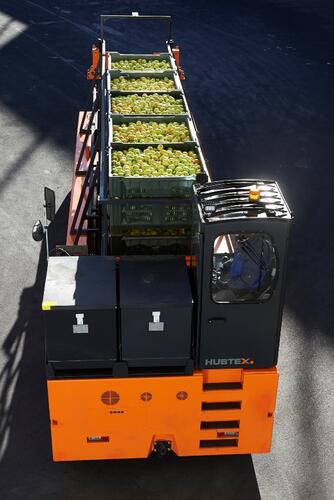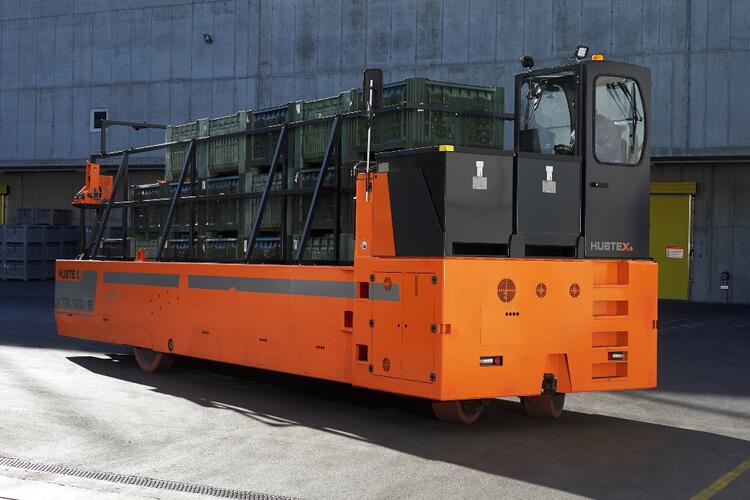MIVOR, an independent apple growing cooperative, has been using a new inloader from Hubtex since summer 2016 in order to ensure a more efficient material flow at its apple warehouse in Vinschgau. By switching from tractors to the KTR 120 crate transporter, MIVOR is reducing the workload of its employees and increasing capacity while also effectively saving time and costs.
MIVOR, a South Tyrol-based apple growing cooperative founded in 2007, is the biggest fruit processing business in Europe. The 373 members of the cooperative cultivate an area of around 1,000 hectares in the Vinschgau region and produce around 85,000 tonnes of apples per year. Fruit is stored, sorted, inspected and prepared for the food retail industry at its roughly 11-hectare production facility in Latsch. After the harvest season in autumn, farmers bring apples to the cooperative in standardised crates. The fruit is initially stored in around 200 cold storage units, which each have a capacity of up to 3,000 crates. At a temperature of 4 degrees Celsius, oxygen is removed from the indoor atmosphere and nitrogen pumped in. This helps to slow down the ripening process and allows the apples to be stored all year round. From the cold storage units, the apple crates are transported to an automated sorting facility where the fruit is identified by a camera system, sorted according to quality, colour and weight, and inspected for features such as sugar content and internal damage. It is at this point that Hubtex lends a helping hand.
The challenge: long transport routes, confined spaces
The cold storage units are spread out and linked by central aisleways across MIVOR's 11-hectare premises. For the loading process, the cooperative has in the past relied on a tractor and trailers as well as several forklifts for the 500-metre-long trips from the cold storage units to the sorting facility. The packaging system can process 120 crates of fruit per hour. In order to ensure optimal capacity utilisation, MIVOR previously required up to four employees and numerous trips when transporting the crates. The crates were picked up by the forklifts from side aisles and subsequently loaded onto the trailers from both sides. The tractor then transported the crates to the sorting facility, while the forklifts unloaded the apple crates and placed them on the conveyor belt. For cold storage units located further away, an insufficient amount of goods were being brought to the facility – even with a high deployment of personnel. For closer units, in contrast, surplus capacities were the problem. "In addition to the high organisational efforts involved, the use of the diesel-powered tractor in enclosed areas presented a challenge. Concerned about the health of our employees and the quality of our food products, we looked for alternative solutions," says Kurt Wellenzohn, technical director at MIVOR. It was through partners LTW Intralogistics and Schmid Anlagenbau – both manufacturers of material-handling technology – that the cooperative reached out to Hubtex. "We were given the task of developing a vehicle that could navigate its way through the narrow aisles due to its compact dimensions and also be able to pick up 28 crates simultaneously from the floor," recalls Kai Hofmann, country sales manager at Hubtex.
The solution: KTR 120 crate transporter
Working to the requirements of the apple growing cooperative, Hubtex developed the KTR 120 inloader, which MIVOR has been using since June 2016. The apple crate transporter has a load carrying capacity of 12 tonnes and can pick up seven batches of up to four crates. It can also transport up to 144 crates per hour. In addition, Hubtex fitted the vehicle with a battery-powered drive to comply with the cooperative's hygiene requirements. The inloader can cover distances of up to 50 kilometres per day thanks to its two large lead-acid batteries. At 10 metres in length and 2.40 metres in width, the vehicle is also able to drive through the side aisles right up to the cold storage units. The load is picked up via a synchronous lifting of the chassis using a lifting rail. Each batch of crates is gripped and lifted by a fork in the wheel arms, meaning the use of additional transport pallets is no longer required. The sensitive loads are also carefully secured during transport. Two hydraulic clamps keep the apple crates fixed on the KTR. Upon arrival at the sorting facility, the driver sets down the crates on the floor without any assistance required. When returning to the cold storage units, the driver takes back the empty crates, with the number of required trips minimised further. Vehicle ergonomics have also been improved: Whereas employees in the past often had to drive in reverse due to the confined spaces created by the tractor being used, the driver now sits at a 90 degree angle to the direction of travel in the KTR. "Since we have been using the KTR, our working processes have become considerably more efficient and also more flexible," reports Wellenzohn. As only one employee is needed for transport and an additional worker for setting up the crates in front of the cold storage units, personnel resources can be deployed more efficiently. "We are now able to better manage peak periods while the driver of the apple crate transporter can also regulate the material flow by leaving empty crates on the return trip, for instance."
MIVOR operates at full capacity after the harvest season. Employees open a cold storage unit every day and bring the apples to the sorting facility. The goods are subsequently transported in a fully automated manner to the high-bay warehouse where they are stored until being sold. MIVOR processes up to 1,300 crates per day and around 30 tonnes of apples per hour. The apple crate transporter ultimately helps the cooperative to ensure a more efficient material flow in its product warehouse while also observing the health of its employees.



